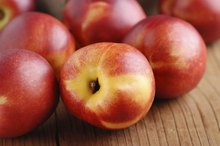Glycemic Index and Carrot Juice
The glycemic index, or GI, of a food indicates how quickly and how high a food will raise blood glucose levels. By following a diet rich in low GI foods, such as carrot juice, those with diabetes can work to better manage blood glucose levels. While carrot juice does contain sugar and carbohydrates, because it is a low GI food, it will not cause a rapid rise in blood glucose levels. A diet based on GI can be difficult to follow and, like all diets, may not work for everyone.
Glycemic Index
When you eat carbohydrates, your body breaks them down into sugars called glucose. The body uses glucose for energy. Different foods contain different types of carbohydrates, which can affect how quickly the food is broken down into glucose and used by the body. The GI measures how much a food raises your blood glucose level. Foods with a high GI are broken down faster and may raise your blood glucose levels more quickly than foods with a low GI. Foods with no carbohydrates, such as fats and meats, have no GI rating.
- When you eat carbohydrates, your body breaks them down into sugars called glucose.
- Different foods contain different types of carbohydrates, which can affect how quickly the food is broken down into glucose and used by the body.
High GI Foods
Nectarines and the Glycemic Index
Learn More
Foods that have a high GI can cause blood sugar levels to spike very quickly after meals. You may even feel energized, but the feeling will not last long. When blood sugar levels are elevated, the body releases insulin to help bring blood glucose levels back down. Because of this, high GI foods may perk you up for a short period, but soon after, you will feel very sluggish and hungry. A GI over 60 is generally considered to be high. Foods with a high GI include sugars, syrups, sodas, white bread, cookies, cakes, potatoes, rice cereal, corn flakes, pineapple, pretzels and ice cream.
- Foods that have a high GI can cause blood sugar levels to spike very quickly after meals.
Low GI Foods
Foods with a low GI are used more slowly by the body. These foods are broken down into glucose, and the glucose is used by the body over a longer period. This results in a slow, gradual rise in blood glucose levels. Following a diet rich in low GI foods may help to keep blood glucose levels lower throughout the day. Because these foods are broken down more slowly, they may also help to control your hunger, which may help with weight loss. Foods with a GI below 50 include beans, milk, apples, peanuts and whole grains -- and carrot juice.
- Foods with a low GI are used more slowly by the body.
- Because these foods are broken down more slowly, they may also help to control your hunger, which may help with weight loss.
Carrot Juice
What Happens to Sugar Levels in the Blood While Fasting?
Learn More
The average GI for an 8-oz. serving of carrot juice is 43, according to the Glycemic Index Foundation and the University of Sydney. Carrot juice will raise blood glucose levels, but because it is a low GI food, it will not cause a rapid rise in blood glucose levels.
Related Articles
References
- The University of Sydney, Home of the Glycemic Index: GI Database: Carrot Juice
- The American Journal of Clinical Nutrition: International Table of Glycemic Index and Glycemic Load Values--2002
- National Institute of Diabetes and Digestive and Kidney Diseases. Diabetes diet, eating, & physical activity. Published December 2016.
- American Diabetes Association. The big picture: Checking your blood glucose.
- American Diabetes Association. 6. Glycemic Targets: Standards of Medical Care in Diabetes-2020. Diabetes Care. 2020;43(Suppl 1):S66-S76. doi:10.2337/dc20-S006
- American Diabetes Association. 14. Management of diabetes in pregnancy: Standards of medical care in diabetes-2020. Diabetes Care. 2020;43(Suppl 1):S183-S192. doi:10.2337/dc20-S014
- Porcellati F, Lucidi P, Bolli GB, Fanelli CG. Thirty years of research on the dawn phenomenon: Lessons to optimize blood glucose control in diabetes. Diabetes Care. 2013;36(12):3860-2. doi:10.2337/dc13-2088
- American Diabetes Association. 5. Lifestyle management: Standards of medical care in diabetes-2019. Diabetes Care. 2019;42(Suppl 1):S46-60. doi:10.2337/dc19-S005
- Colberg SR, Sigal RJ, Yardley JE, et al. Physical activity/exercise and diabetes: A position statement of the American diabetes association. Diabetes Care. 2016;39(11):2065-2079. doi:10.2337/dc16-1728
- American Diabetes Association (ADA). Understanding A1C.
- Garber AJ, Abrahamson MJ, Barzilay JI, et al. Consensus statement by the American association of clinical endocrinologists and American college of endocrinology on the comprehensive type 2 diabetes management algorithm - 2019 executive summary. Endocr Pract. 2019;25(1):69-100. doi:10.4158/CS-2018-0535
Writer Bio
Emily Creasy began writing professionally in 2010. As a registered and licensed dietitian her writing focuses on weight loss, disease-specific diets and diet-friendly cooking. She holds a Bachelor of Science in human nutrition, foods and exercise from Virginia Tech and a Master of Science in dietetics from James Madison University.









